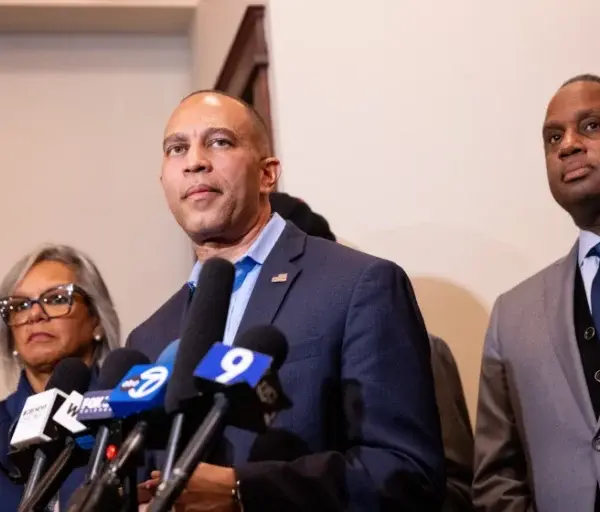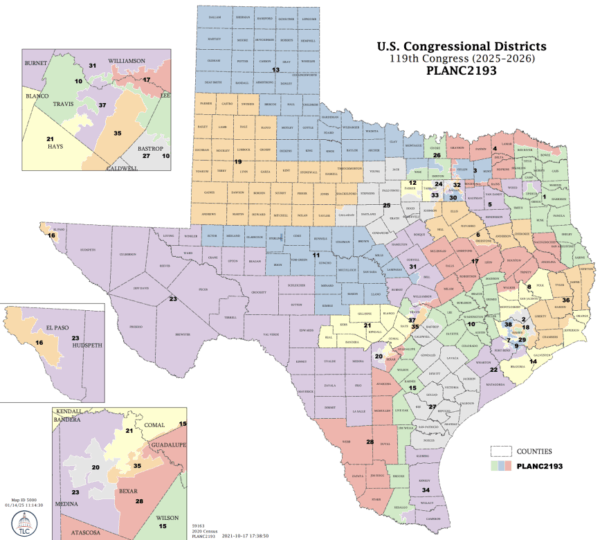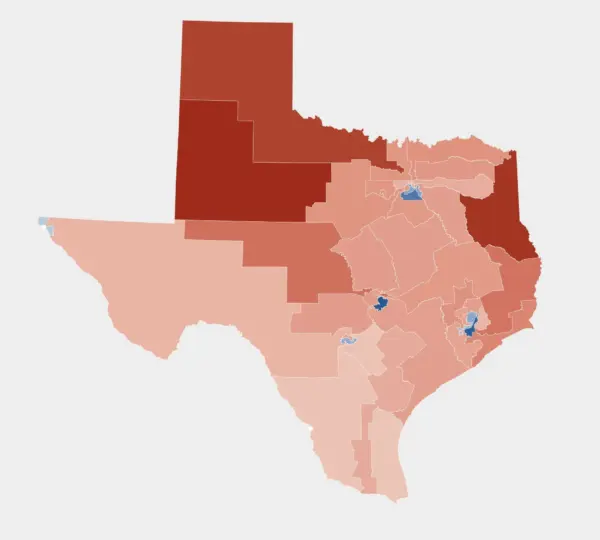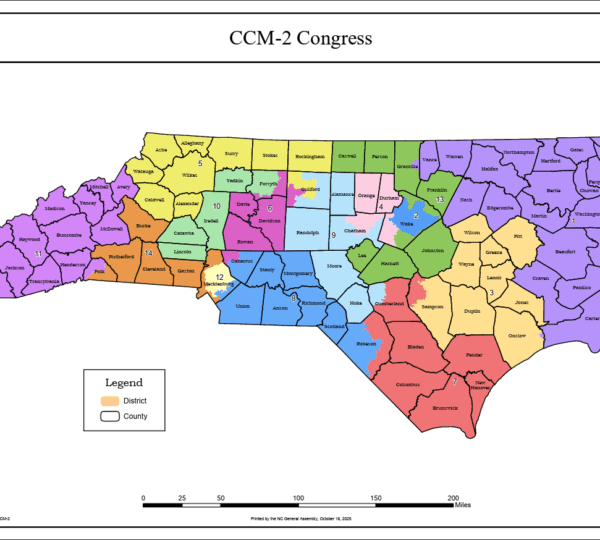The political landscape in the United States is undergoing one of the most dramatic transformations in recent years, and much of this shift is happening quietly behind the scenes.
Redistricting, a process that typically draws limited public attention, has now become a central battlefield as Republicans accelerate efforts across several states to reshape congressional districts in their favor.
This national push has not emerged in isolation.It is part of a coordinated movement encouraged — and in some cases directly pushed — by former President Donald Trump and his closest allies.
Trump has urged Republican-controlled legislatures to act quickly and aggressively, insisting that the window for reshaping the map before the next election cycle is limited.

As a result, states that once adhered to cautious, decade-based redistricting cycles are now redrawing lines mid-decade.
This approach, once considered unusual, is increasingly becoming the new political reality.
Among all these developments, one figure has emerged as the loudest and most forceful Democratic voice: House Minority Leader Hakeem Jeffries.
Jeffries’ reaction to the GOP-led redistricting wave has been strong, highly visible, and deeply rooted in concerns over democratic representation.
North Carolina became the latest flashpoint in this expanding conflict when Republican lawmakers unveiled a new congressional map.
The map was designed with a clear goal — to create at least one additional GOP-leaning district and further strengthen the Republican presence in the U.S. House.
The redesign was pushed rapidly through the state legislature, with strong backing from Trump-aligned strategists.
Analysts quickly noted that the new lines heavily favored Republicans, partly by consolidating Democratic voters into fewer districts.
North Carolina Senator Ralph Hise, a key architect of the new map, did not hesitate to confirm the political motivation.

He stated openly that the redraw was intended to deliver Republicans “an additional congressional seat.”
This blunt admission sparked immediate backlash from Democrats.
Jeffries responded by calling the move a deliberate attempt to tilt the political playing field.
To him, the North Carolina plan represents not just another partisan maneuver but part of a national strategy aimed at cementing control of Congress through technical manipulation rather than voter choice.
Democrats argue that tactics like “packing” and “cracking” voters distort the democratic process and weaken meaningful representation.
Public hearings in North Carolina drew protests.
Citizens expressed concern that the map could reduce the political influence of minority communities and urban populations.
Despite these objections, the North Carolina Senate passed the proposal swiftly.
Now, it heads to the state House, where Republicans also maintain a strong majority.

Because state law does not allow Governor Josh Stein — a Democrat — to veto redistricting plans, Republicans hold near-total control.
This lack of executive oversight has amplified Democratic concerns.
The situation in North Carolina is far from isolated.
Across the country, Republicans are pursuing similar strategies in states where they hold legislative power.
Texas has become one of the most significant battlegrounds in this redistricting surge.
Republican lawmakers there introduced a sweeping proposal that could create up to five new GOP-leaning districts.
Supporters argue that the plan reflects Texas’ shifting population.
Critics counter that it dilutes urban and minority voters who have fueled much of the state’s growth.
Missouri has also moved forward with a controversial new map.
Its designers intended it to produce an additional Republican seat.

However, the map is now facing multiple legal challenges, and activists have launched petitions to overturn the changes.
The outcome remains uncertain as the legal battle intensifies.
Meanwhile, even deep-blue California has taken an unexpected turn.
Governor Gavin Newsom, widely considered a potential 2028 presidential candidate, supports a ballot initiative that could temporarily pause the state’s independent redistricting commission.
If passed, the state legislature would be allowed to draw as many as five new Democrat-leaning districts.
This move is widely seen as a direct counterpunch to GOP-led redistricting efforts elsewhere.
The proposal has sparked debate within California.
Supporters say it is necessary to balance national political shifts.
Opponents argue it undermines the spirit of independent redistricting and risks damaging the state’s credibility.
Nevertheless, the initiative will go before voters in November.

Kansas is also preparing for a potential redistricting overhaul.
Lawmakers have allocated nearly $500,000 for the possibility of a special session.
Their target appears to be the district of Democratic Congresswoman Sharice Davids.
By altering that district’s boundaries, Republicans may significantly weaken Democratic chances in a heavily conservative state.
Indiana has found itself pulled into the national spotlight as well.
Despite already holding a 7–2 advantage in U.S. House seats, Republicans there are considering redrawing lines to target another Democratic-held district.
Reports indicate that the White House — now under Trump — has encouraged Indiana Republicans to pursue this strategy.
Vice President J.D. Vance has personally visited lawmakers to discuss the effort.
In Ohio and Utah, ongoing redistricting disputes have continued for years.
The arrival of new proposals has reignited legal and political tension.

Despite differences from state to state, the overall trend is unmistakable.
Republicans are using every available tool to shape congressional representation.
Jeffries believes these actions threaten the democratic foundation of the House of Representatives.
He argues that the new maps marginalize minority communities and reduce voter competition.
According to Jeffries, redistricting has shifted from being a technical process to becoming a political weapon.
He warns that if these maps go unchallenged, they could cement Republican control for an entire decade.
Republicans strongly reject these criticisms.
They argue that they are operating fully within the law.
They also point out that Democrats have historically pursued favorable maps when holding power.
California’s latest proposal provides ammunition for this argument.
Political analysts agree that the redistricting wars will shape the 2026 congressional elections.
The stakes are immense.
The battle will involve courts, state legislatures, election commissions, advocacy groups, and national political figures.
Each decision will affect the broader balance of power in Washington.
Public trust may also be at risk.
When citizens feel their vote matters less due to the shape of a district, confidence in the system declines.
Jeffries’ warnings reflect this broader concern.
For him, this is not just a partisan dispute but a battle for democratic integrity.
Republicans see it differently.
They view redistricting as a necessary strategy to reflect changing voter dynamics.
Both sides believe they are defending democracy.
Both argue they are acting for the greater good of their voters.
And both are preparing for a long and intense political fight.
The national map of congressional districts is being rewritten.
Not just on paper.
But in ways that may reshape American politics for years to come.
The outcome of this struggle will determine far more than district lines.
It may decide who controls Congress.
It may influence the direction of national policy.
It may shape the balance between the political parties for an entire generation.
As the country watches, the battle continues — slowly, quietly, but with enormous consequences.
And the story is far from over.
The political landscape in the United States is undergoing one of the most dramatic transformations in recent years, and much of this shift is happening quietly behind the scenes.
Redistricting, a process that typically draws limited public attention, has now become a central battlefield as Republicans accelerate efforts across several states to reshape congressional districts in their favor.
This national push has not emerged in isolation.It is part of a coordinated movement encouraged — and in some cases directly pushed — by former President Donald Trump and his closest allies.
Trump has urged Republican-controlled legislatures to act quickly and aggressively, insisting that the window for reshaping the map before the next election cycle is limited.

As a result, states that once adhered to cautious, decade-based redistricting cycles are now redrawing lines mid-decade.
This approach, once considered unusual, is increasingly becoming the new political reality.
Among all these developments, one figure has emerged as the loudest and most forceful Democratic voice: House Minority Leader Hakeem Jeffries.
Jeffries’ reaction to the GOP-led redistricting wave has been strong, highly visible, and deeply rooted in concerns over democratic representation.
North Carolina became the latest flashpoint in this expanding conflict when Republican lawmakers unveiled a new congressional map.
The map was designed with a clear goal — to create at least one additional GOP-leaning district and further strengthen the Republican presence in the U.S. House.
The redesign was pushed rapidly through the state legislature, with strong backing from Trump-aligned strategists.
Analysts quickly noted that the new lines heavily favored Republicans, partly by consolidating Democratic voters into fewer districts.
North Carolina Senator Ralph Hise, a key architect of the new map, did not hesitate to confirm the political motivation.

He stated openly that the redraw was intended to deliver Republicans “an additional congressional seat.”
This blunt admission sparked immediate backlash from Democrats.
Jeffries responded by calling the move a deliberate attempt to tilt the political playing field.
To him, the North Carolina plan represents not just another partisan maneuver but part of a national strategy aimed at cementing control of Congress through technical manipulation rather than voter choice.
Democrats argue that tactics like “packing” and “cracking” voters distort the democratic process and weaken meaningful representation.
Public hearings in North Carolina drew protests.
Citizens expressed concern that the map could reduce the political influence of minority communities and urban populations.
Despite these objections, the North Carolina Senate passed the proposal swiftly.
Now, it heads to the state House, where Republicans also maintain a strong majority.

Because state law does not allow Governor Josh Stein — a Democrat — to veto redistricting plans, Republicans hold near-total control.
This lack of executive oversight has amplified Democratic concerns.
The situation in North Carolina is far from isolated.
Across the country, Republicans are pursuing similar strategies in states where they hold legislative power.
Texas has become one of the most significant battlegrounds in this redistricting surge.
Republican lawmakers there introduced a sweeping proposal that could create up to five new GOP-leaning districts.
Supporters argue that the plan reflects Texas’ shifting population.
Critics counter that it dilutes urban and minority voters who have fueled much of the state’s growth.
Missouri has also moved forward with a controversial new map.
Its designers intended it to produce an additional Republican seat.

However, the map is now facing multiple legal challenges, and activists have launched petitions to overturn the changes.
The outcome remains uncertain as the legal battle intensifies.
Meanwhile, even deep-blue California has taken an unexpected turn.
Governor Gavin Newsom, widely considered a potential 2028 presidential candidate, supports a ballot initiative that could temporarily pause the state’s independent redistricting commission.
If passed, the state legislature would be allowed to draw as many as five new Democrat-leaning districts.
This move is widely seen as a direct counterpunch to GOP-led redistricting efforts elsewhere.
The proposal has sparked debate within California.
Supporters say it is necessary to balance national political shifts.
Opponents argue it undermines the spirit of independent redistricting and risks damaging the state’s credibility.
Nevertheless, the initiative will go before voters in November.

Kansas is also preparing for a potential redistricting overhaul.
Lawmakers have allocated nearly $500,000 for the possibility of a special session.
Their target appears to be the district of Democratic Congresswoman Sharice Davids.
By altering that district’s boundaries, Republicans may significantly weaken Democratic chances in a heavily conservative state.
Indiana has found itself pulled into the national spotlight as well.
Despite already holding a 7–2 advantage in U.S. House seats, Republicans there are considering redrawing lines to target another Democratic-held district.
Reports indicate that the White House — now under Trump — has encouraged Indiana Republicans to pursue this strategy.
Vice President J.D. Vance has personally visited lawmakers to discuss the effort.
In Ohio and Utah, ongoing redistricting disputes have continued for years.
The arrival of new proposals has reignited legal and political tension.

Despite differences from state to state, the overall trend is unmistakable.
Republicans are using every available tool to shape congressional representation.
Jeffries believes these actions threaten the democratic foundation of the House of Representatives.
He argues that the new maps marginalize minority communities and reduce voter competition.
According to Jeffries, redistricting has shifted from being a technical process to becoming a political weapon.
He warns that if these maps go unchallenged, they could cement Republican control for an entire decade.
Republicans strongly reject these criticisms.
They argue that they are operating fully within the law.
They also point out that Democrats have historically pursued favorable maps when holding power.
California’s latest proposal provides ammunition for this argument.
Political analysts agree that the redistricting wars will shape the 2026 congressional elections.
The stakes are immense.
The battle will involve courts, state legislatures, election commissions, advocacy groups, and national political figures.
Each decision will affect the broader balance of power in Washington.
Public trust may also be at risk.
When citizens feel their vote matters less due to the shape of a district, confidence in the system declines.
Jeffries’ warnings reflect this broader concern.
For him, this is not just a partisan dispute but a battle for democratic integrity.
Republicans see it differently.
They view redistricting as a necessary strategy to reflect changing voter dynamics.
Both sides believe they are defending democracy.
Both argue they are acting for the greater good of their voters.
And both are preparing for a long and intense political fight.
The national map of congressional districts is being rewritten.
Not just on paper.
But in ways that may reshape American politics for years to come.
The outcome of this struggle will determine far more than district lines.
It may decide who controls Congress.
It may influence the direction of national policy.
It may shape the balance between the political parties for an entire generation.
As the country watches, the battle continues — slowly, quietly, but with enormous consequences.
And the story is far from over.





